Smoking is still one of the biggest threats to health in the United States, leading to diseases and early deaths that could be avoided. When you smoke, you’re not just harming your lungs—you’re affecting your entire body.
Cigarettes are filled with over 5,000 chemicals, including nicotine, which is highly addictive. But the real danger comes from substances like tar and carbon monoxide, which can cause cancer and other serious health issues.
Every time you take a puff, these harmful chemicals travel through your bloodstream, reaching and damaging nearly every part of your body, from your skin to your brain. Smoking is responsible for more deaths each year than HIV, illegal drug use, alcohol, car accidents, and firearm-related incidents combined.
Let’s dive into some important smoking statistics to better understand its impact on health, society, and global trends.
Smoking Statistics

Tobacco use is the number one cause of disease, disability, and death that can be prevented in the United States. In the United States, smokers—both men and women—have a death rate that is about three times higher than people who have never smoked. This higher risk of death is mainly due to smoking-related diseases like cancer, chronic obstructive pulmonary disease, and heart problems.
- The CDC reports that every year, more than 480,000 people die due to smoking, including those affected by secondhand smoke. This includes about 278,544 men and 201,773 women who lose their lives annually because of tobacco use, including secondhand smoke exposure. This is almost one in five deaths every year in the US. (1)
- In 2018, cigarette smoking imposed a financial burden of over $600 billion on the United States. Tobacco use leads to huge economic costs, including the high expenses of treating diseases caused by smoking and the loss of productivity due to illness and premature death related to tobacco use. (1)
- CDC states that more than $240 billion was spent on healthcare expenses and nearly $372 billion was lost due to reduced productivity. (1)
- In 2021, nearly 12 out of every 100 U.S. adults aged 18 and older (11.5%) were current cigarette smokers. This adds up to about 28.3 million adults in the United States who were smoking at that time. “Current smokers” refers to people who have smoked at least 100 cigarettes in their lifetime and were still smoking, either every day or on some days, when they took part in the survey. (1)
Cigarette Smoking Trends (1965-2019)
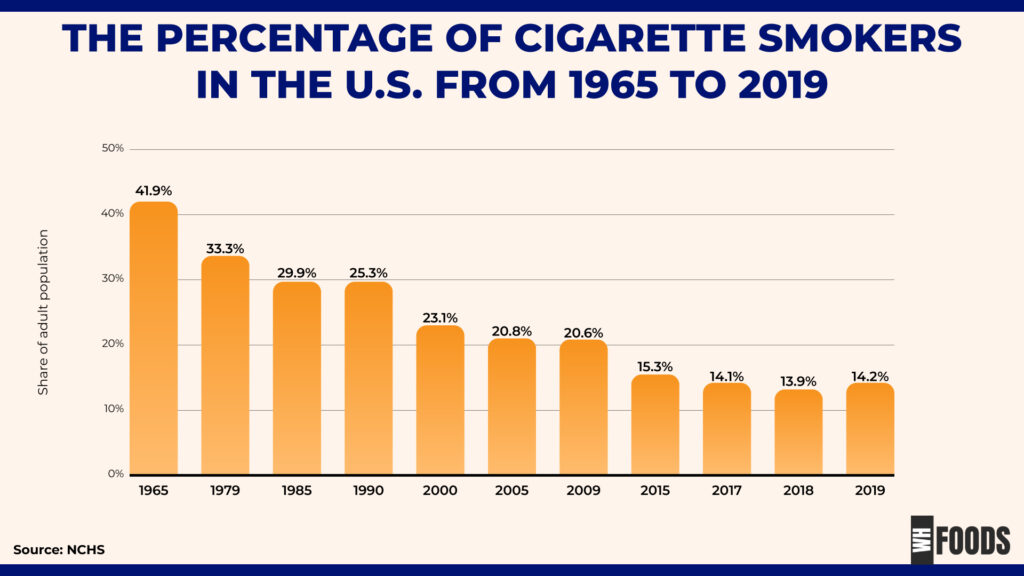
The drop in smoking rates in the United States over the past few decades is due to several factors, including strict rules on cigarette advertising and sales, higher cigarette prices, and more people becoming aware of the dangers of smoking.
Years of public awareness campaigns highlighting the health risks of smoking, along with state and local bans on indoor smoking in public places, have led to a significant cultural shift in how many Americans now view smoking.
- Between 1965 and 2019, the rate of cigarette smoking in the U.S. fell by two-thirds from approximately 42 percent to 14 percent among adults. (2)
Current Cigarette Smokers by Gender (1965-2019)
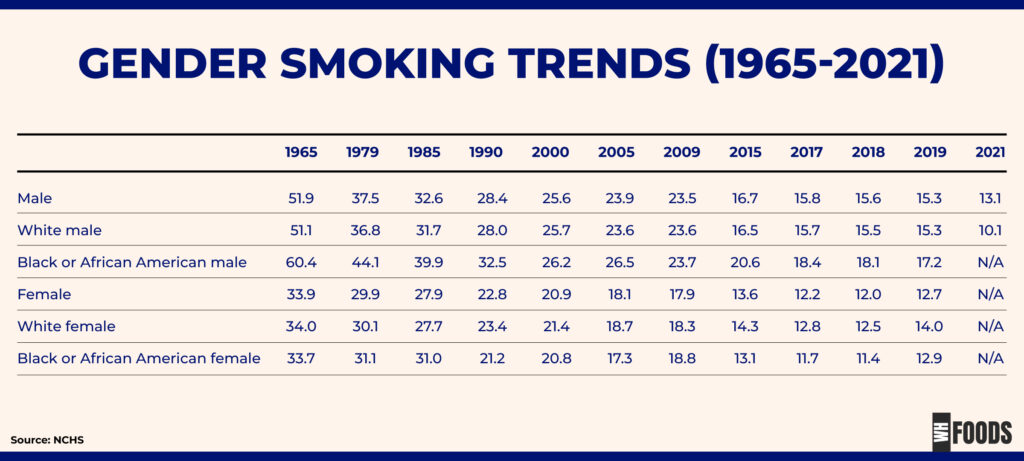
Even though smoking in the U.S. has gone down a lot over the past few decades, it’s still more common in some groups than others. For example, men are more likely to smoke cigarettes than women. (2)
- In 1965, 51.9% of men smoked, compared to just 13.1% in 2021. (13)
- White males showed a similar trend, with a drop from 51.1% in 1965 to 15.3% in 2019.
- Black or African American males also saw a significant decline, from 60.4% in 1965 to 17.2% in 2019, although they consistently had higher smoking rates than white males until recent years.
- Female smoking rates dropped from 33.9% in 1965 to 10.1% in 2021, a slower decline compared to males. (13)
- White females showed a decrease from 34.0% in 1965 to 14.0% in 2019.
- Black or African American females saw a decrease from 33.7% in 1965 to 12.9% in 2019, with the most significant reductions occurring after 2000.
Tobacco Product Use Among U.S. Adults by Gender in 2021
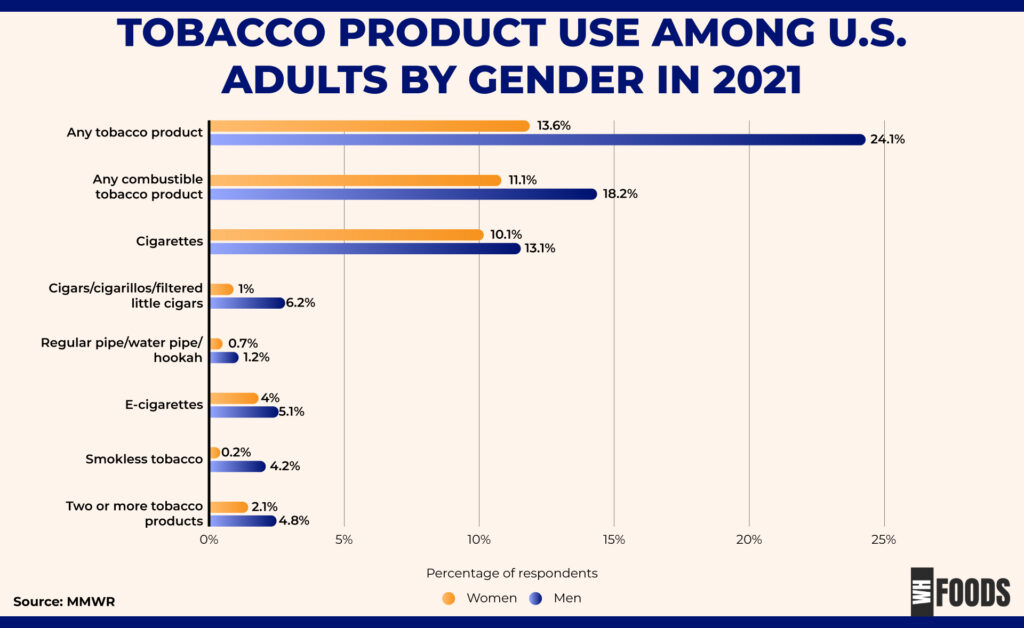
- In 2021, roughly 24 percent of men in the United States used tobacco products, compared to only 14 percent of women. This information comes from the 2021 National Health Interview Survey (NHIS), which also looked at how common it is for people to use five different tobacco products: cigarettes, e-cigarettes, cigars, pipes, and smokeless tobacco. (3)
U.S. College Students’ Tobacco Use in the Last 3 Months (Fall 2023)
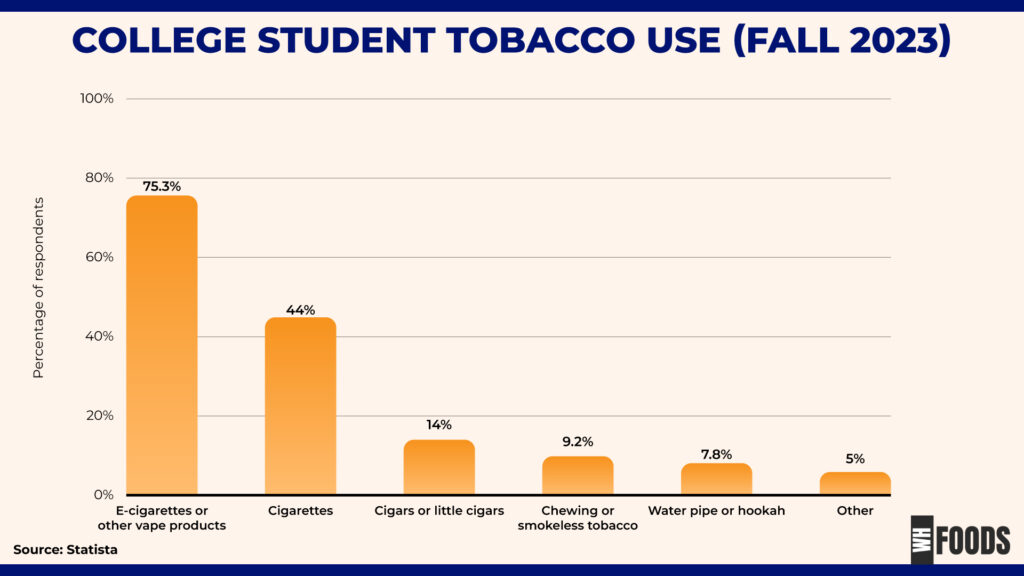
A survey from the fall of 2023 found that the most popular tobacco products among college students in the United States were e-cigarettes or other vaping devices.
- Approximately 75 percent of college students who used tobacco products in the past three months reported using e-cigarettes or other vaping devices. The survey also found that among college students who had ever used a tobacco product, about 24 percent said they used tobacco daily or almost daily in the past three months, while 26 percent had only used it once or twice. (4)
Lifetime Cigarette use among U.S. grades 8-12, 1991-2023
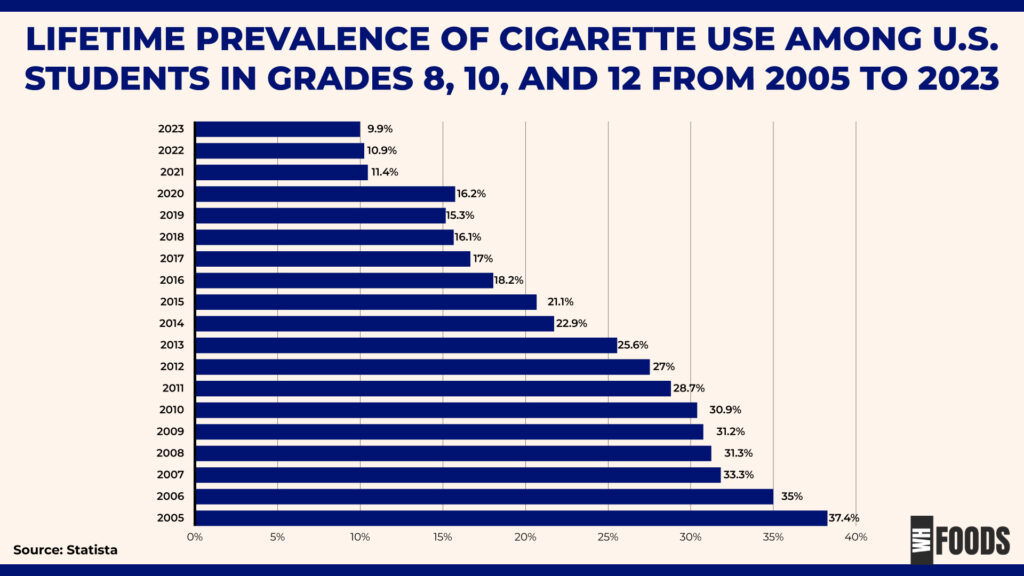
Tobacco use among U.S. middle and high school students remains a significant concern. This overview highlights the current trends and the need for ongoing efforts to address youth tobacco use.
- In 2023, about ten percent of U.S. students in grades 8, 10, and 12 reported having smoked cigarettes at some point in their lives. This statistic shows how many students in grades 8, 10, and 12 have ever tried cigarettes at least once from 1991 to 2023. (5)
- As of 2023, about 2.1 percent of U.S. students in grades 8, 10, and 12 reported using cigarettes in the past 30 days. (6)
Tobacco Use Trends in U.S. Middle and High Schools

Using any form of tobacco is dangerous for young people. With so many middle and high school students using tobacco products, it’s essential to continue efforts to prevent them from starting and to provide support to help those who already use tobacco to quit. These actions are key to reducing tobacco use among U.S. youth.
1. By Product
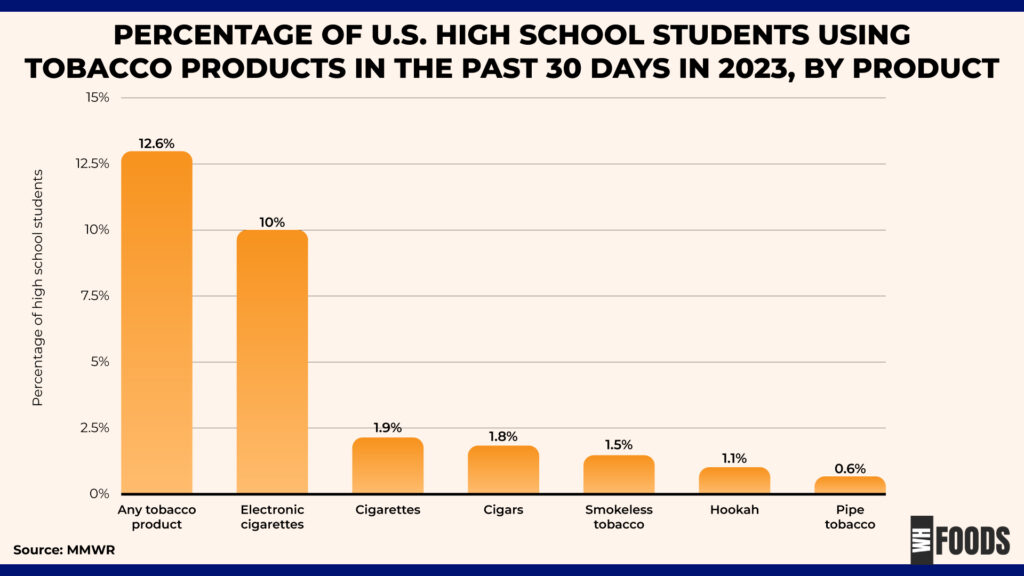
- In 2023, about 10 percent of high school students used electronic cigarettes in the past month, compared to 2 percent who used cigarettes. Using tobacco products during adolescence raises the risk of becoming addicted to nicotine for life and can lead to serious health problems. (7)
2. By Gender
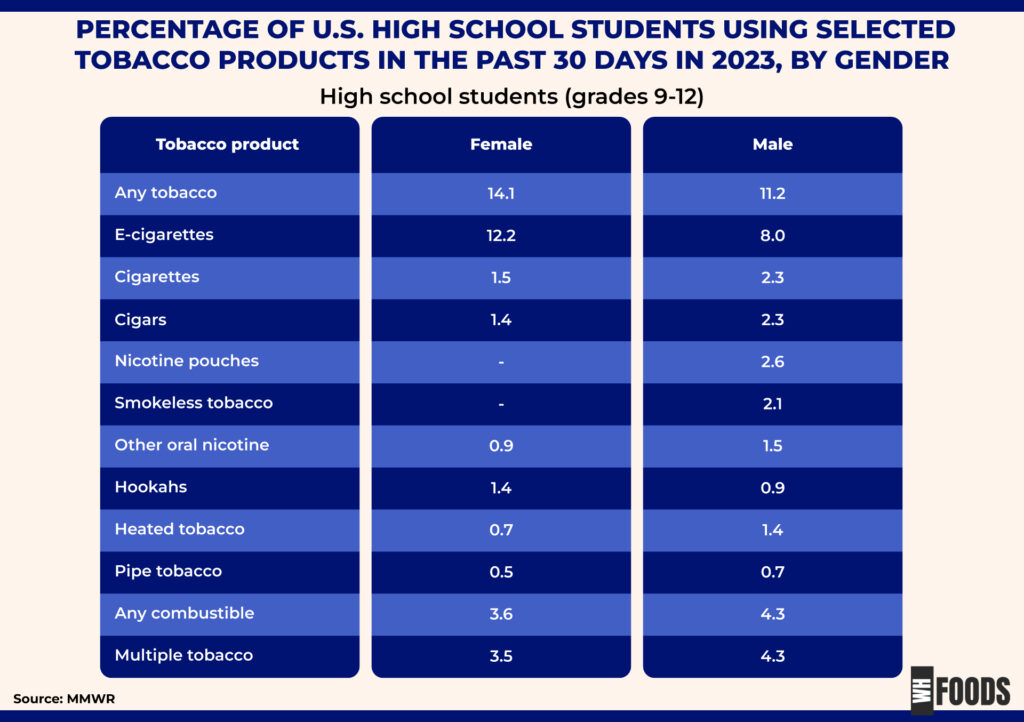
- In 2023, approximately 12 percent of female high school students used electronic cigarettes in the past month, while 8 percent of males did. The higher usage among females may reflect changing social dynamics, targeted marketing, or different stress factors impacting young women, indicating the need for gender-specific approaches in tobacco prevention and education efforts. (7)
3. By Race and Ethnicity
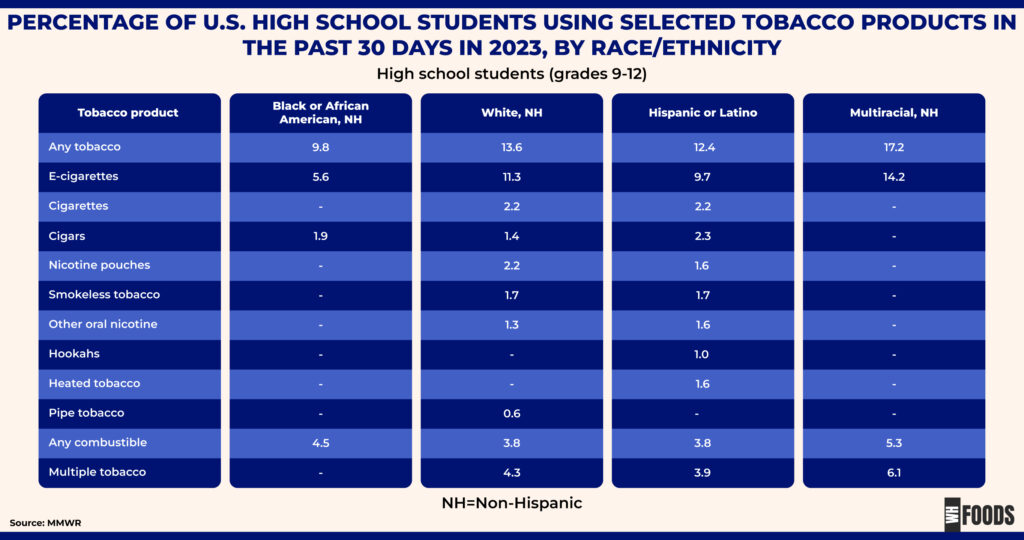
- In 2023, about 11 percent of White, non-Hispanic high school students used electronic cigarettes in the past month, compared to 5.6 percent of Black, non-Hispanic students. This disparity may reflect differences in cultural norms, socioeconomic factors, or the effectiveness of targeted public health campaigns. It could also indicate varying levels of exposure to e-cigarette marketing and access to these products among different racial and ethnic groups. (7)
Lowering Youth Tobacco Use
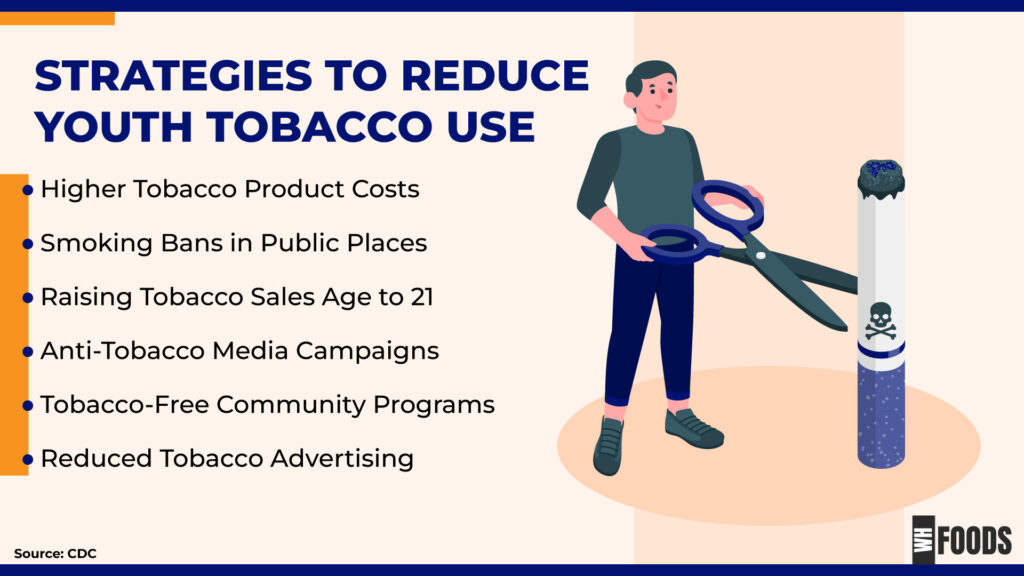
Stopping young people from starting to use tobacco is key to reducing overall tobacco use among the nation’s youth. Most people start using tobacco products during their teenage years.
- When implemented together, national, state, and local program activities have proven effective in reducing and preventing youth tobacco use. (8)
Smoking Rates Among U.S. Adults 65+ (2013-2021)
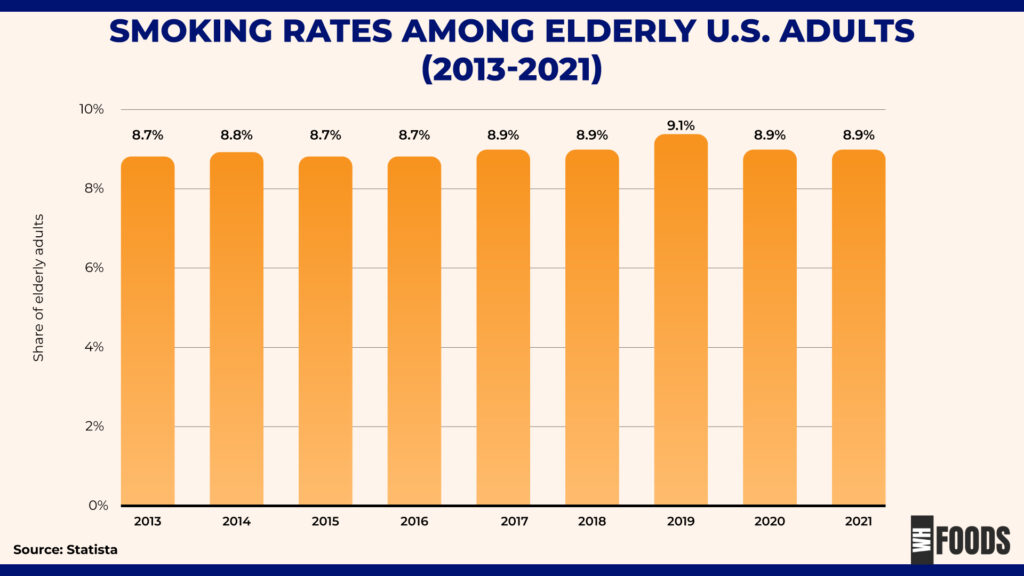
Between 2011 and 2022, smoking rates dropped among American adults, except for those aged 65 and older. In this age group, loneliness was linked to both a higher likelihood of smoking and smoking more cigarettes each day. (9)
- In 2021, an estimated 8.9 percent of elderly adults in the United States were cigarette smokers.
- Over the period from 2013 to 2021, the smoking rate among elderly U.S. adults remained relatively stable, fluctuating slightly between 8.7% and 9.1%.
Despite overall declines in smoking across other age groups, this data suggests that elderly adults have not experienced the same reductions in smoking rates, potentially pointing to unique challenges faced by this population.
Daily Cigarette Consumption in the U.S. (December 2023)
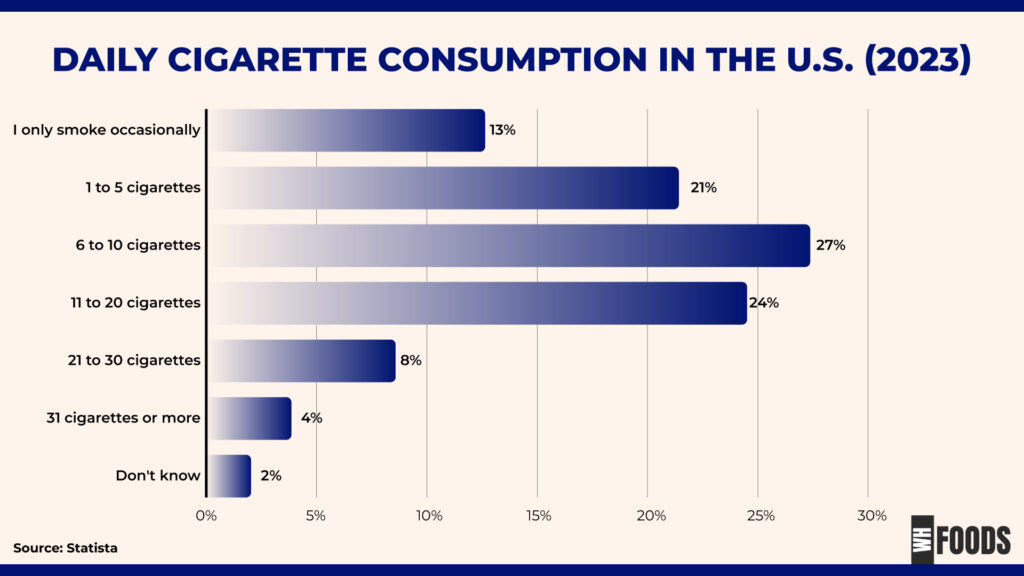
Daily cigarette consumption in the U.S. varies across different groups, reflecting broader health and social trends. Understanding who smokes the most can help tailor public health efforts. Trends in daily cigarette consumption often highlight underlying issues like stress, economic challenges, and social isolation, which can influence smoking habits. By focusing on these factors, we can better address the root causes and reduce smoking rates across the country.
- In a 2023 online survey of 3,592 U.S. consumers, 21 percent reported smoking “1 to 5 cigarettes” per day. (10)
Adult Smoking Rates in 2021
1. By Sex
- Approximately 13 out of every 100 adult men (13.1%) smoked, compared to about 10 out of every 100 adult women (10.1%). More men than women smoke cigarettes. (1)
2. By Age
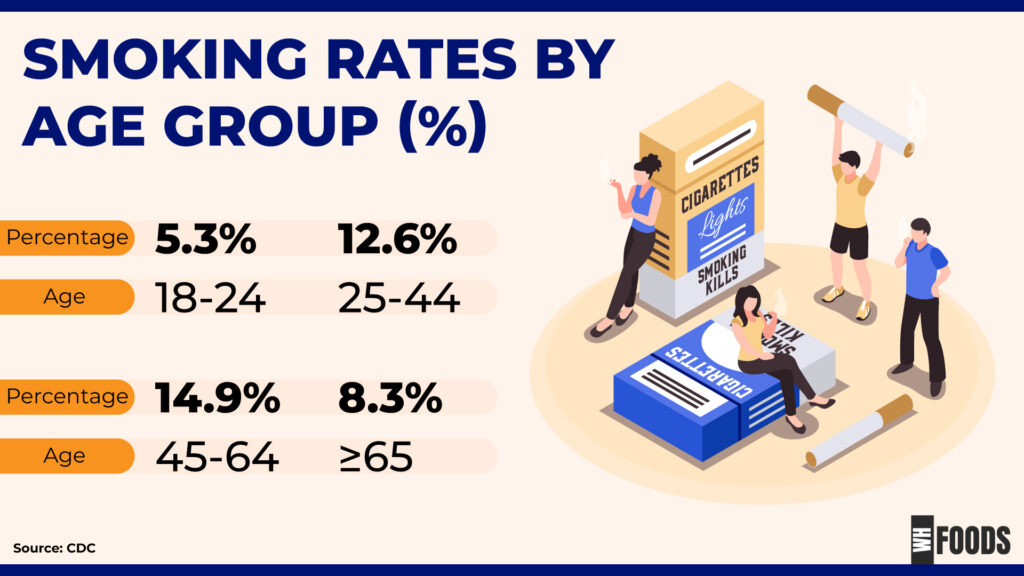
- About 5 out of every 100 adults aged 18–24 years (5.3%) and nearly 13 out of every 100 adults aged 25–44 years (12.6%) reported smoking. The highest rates of current cigarette smoking are found among people aged 25–44 and 45–64 years. The lowest rates are among those aged 18–24 years. (1)
3. By Race and Ethnicity
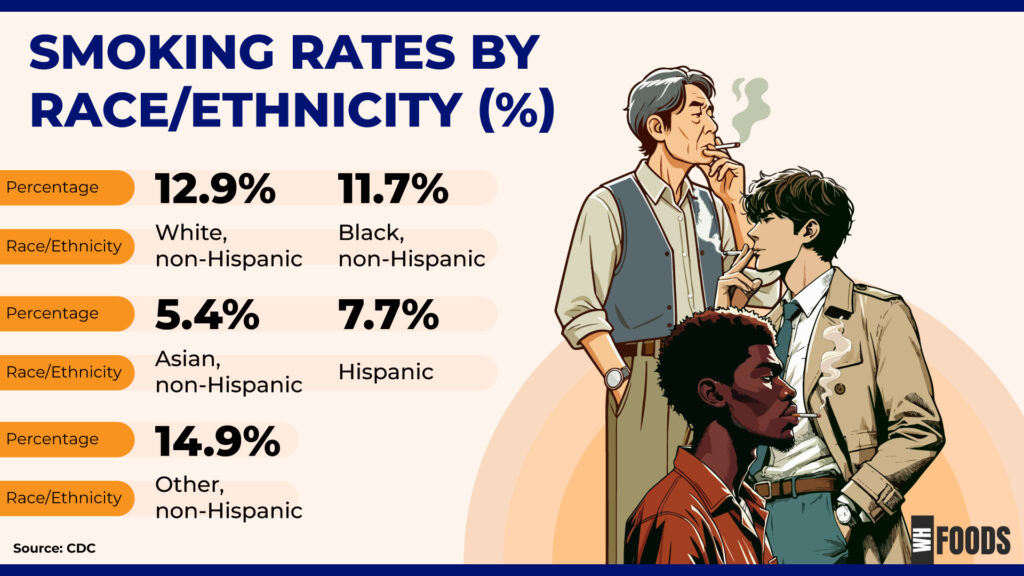
- Nearly 15 out of every 100 non-Hispanic adults from other racial groups (14.9%) currently smoke cigarettes. Smoking rates are highest among non-Hispanic adults from these racial groups and lowest among non-Hispanic Asian adults. (1)
- 13 out of every 100 non-Hispanic White adults (12.9%) reported smoking. (1)
4. By Education
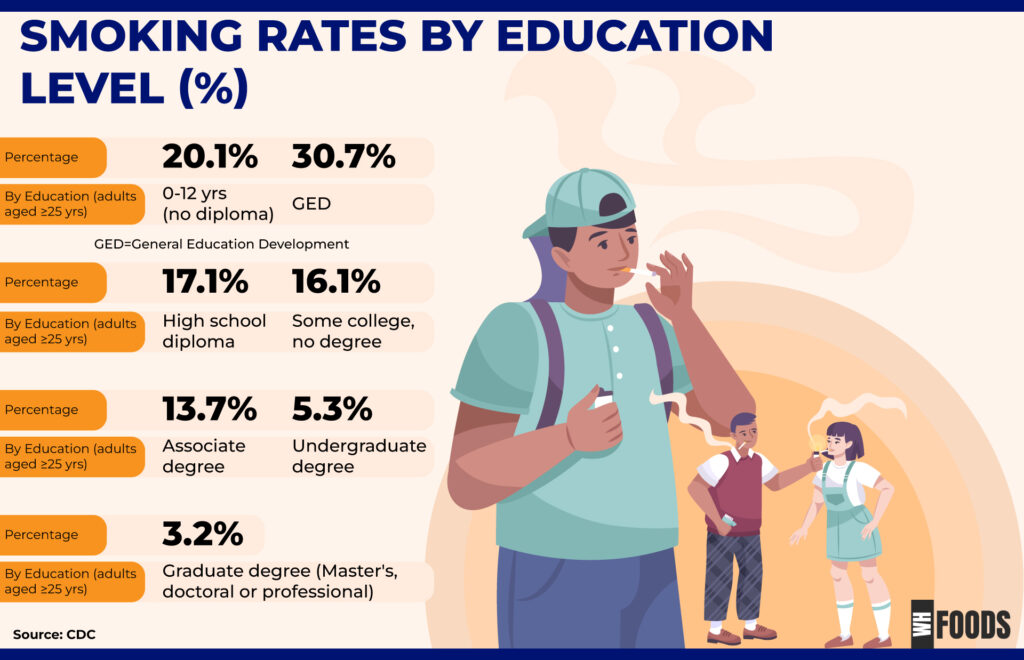
- Nearly 31 out of every 100 adults with a GED certificate (30.7%) smoke cigarettes. Smoking rates are highest among those with a GED and lowest among those with a graduate degree. (1)
- About 20 out of every 100 adults who attended some high school but didn’t earn a degree (20.1%) are current smokers. (1)
Smoking Rates by Annual Household Income (%)
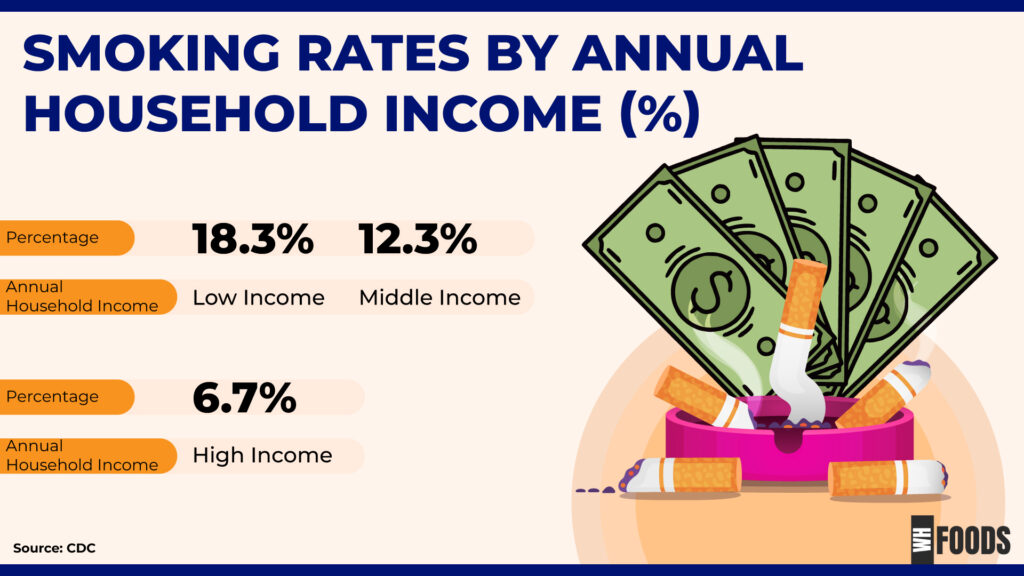
- About 18 out of every 100 adults with low income (18.3%) smoke cigarettes. Smoking rates are higher among people with lower annual household incomes compared to those with higher incomes. (1)
What Country Smokes The Most
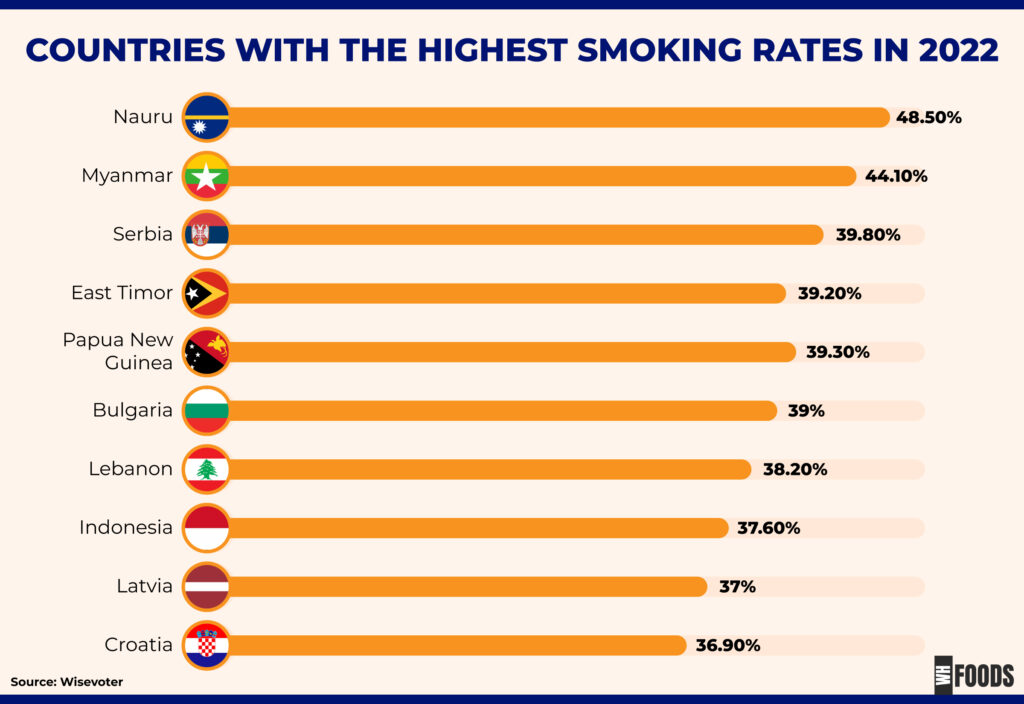
Smoking rates vary widely around the world, influenced by cultural, economic, and regulatory factors that affect how tobacco is consumed. Even with ongoing efforts to control tobacco use, smoking remains a serious global health issue, with different countries showing distinct patterns. Some countries, in particular, have notably high smoking rates that are especially concerning.
- Nauru ranks first among countries with the highest smoking rates, with 48.50% of its population using tobacco products. (11)
- Myanmar, Serbia, Papua New Guinea, and East Timor all have smoking rates that exceed 35%. These countries are struggling to tackle tobacco addiction and reduce the serious health risks that come with it. (11)
State-by-State Adult Cigarette Smoking Rates
State-by-State Adult Cigarette Smoking Rates offer a detailed look at how smoking habits differ across the U.S. This information highlights the regional variations in smoking prevalence, shedding light on the effectiveness of local tobacco control measures and the unique challenges faced by each state in reducing smoking rates. (12)
- California: Reports the highest number of adult smokers at 2,644,835, but with a relatively low smoking rate of 9.70%, reflecting the state’s large population.
- West Virginia: Exhibits the highest smoking rate at 21.00%, indicating a significant public health concern in the state.
- Utah: Shows the lowest smoking rate at 6.70%, demonstrating the state’s effective tobacco control measures.
- Tennessee and Arkansas: Both states have high smoking rates of 18.50% and 18.70%, respectively, highlighting areas with higher tobacco use.
- New York and Florida: Both states have large numbers of smokers (1,551,197 in New York and 1,772,891 in Florida) but relatively moderate smoking rates of 11.30% and 11.30%, respectively.
- Midwestern States: States like Kentucky, Ohio, and Indiana show elevated smoking rates of 17.40%, 17.10%, and 16.20%, respectively, indicating a regional trend of higher tobacco use.
- Southern States: States such as Alabama, Mississippi, and Louisiana have smoking rates ranging from 15.40% to 17.40%, reflecting a persistent public health challenge in the region.
- States with Lower Smoking Rates: Maryland (9.60%), Connecticut (10.00%), and Hawaii (10.00%) are among the states with lower smoking rates, suggesting more successful tobacco control efforts.
- States with Moderate Smoking Rates: States like Arizona (12.70%) and Georgia (12.50%) fall into the middle range, indicating average smoking prevalence.
- Vermont and Wyoming: Both states report moderate smoking rates at 13.00% and 15.50%, respectively, with a smaller number of smokers due to their smaller populations.
Final Thought
Smoking continues to be a major public health issue, contributing to countless cancer deaths, especially from lung cancer, and leading to heart disease and respiratory diseases. The World Health Organization highlights that tobacco smoking remains a leading cause of preventable death worldwide. High-income countries, despite having more resources, still face significant challenges in reducing smoking rates across all age groups. The global burden of tobacco use is immense, with death rates and health consequences affecting millions of people every year.
Efforts to reduce tobacco use, such as increasing tobacco taxes, providing better access to human services, and promoting quit smoking programs, are crucial in lowering smoking rates. Health statistics show that current smoking trends are alarming, but by focusing on health metrics and the direct tobacco costs on society, we can make progress. Every step taken to help tobacco users quit and to educate others about the dangers of direct tobacco use can lead to fewer cancer deaths and a healthier future for everyone.
Sources
- Tips from Former Smokers: Burden of Cigarette Use in the U.S.
- Current cigarette smoking among adults aged 18 and over, by sex, race, and age: United States, selected years 1965–2019
- Tobacco Product Use Among Adults – United States, 2021
- Percentage of college students in the U.S. who reported having used select tobacco products in the last 3 months, as of fall 2023
- Lifetime prevalence of cigarette use for grades 8, 10, and 12 combined from 1991 to 2023
- 30-day prevalence of cigarettes use for grades 8, 10, and 12 combined from 1991 to 2023
- Tobacco Product Use Among U.S. Middle and High School Students — National Youth Tobacco Survey, 2023
- Smoking and Tobacco Use – Youth and Tobacco Use
- Percentage of adults aged 65 years or older in the U.S. who smoked cigarettes from 2013 to 2021
- Cigarettes smoked per day in the U.S. as of December 2023
- Smoking Rates by Country
- Adult Cigarette Smoking by State
- Current Cigarette Smoking Among Adults in the United States







Write a comment
Your email address will not be published. All fields are required